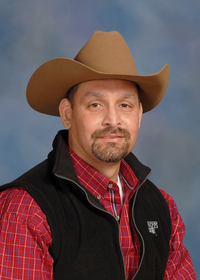Managing Small Pasture for Horses
Horses are an important part of livestock systems in Mississippi. They are used in various activities. A growing number of horse enthusiasts throughout the state are showing interest in pleasure horses. However, land availability could limit a horse owner’s ability to provide enough forage for grazing horses. Horse owners close to urban developments are confined by limited availability of land for pasture. This raises the following questions:
- Which forage species can handle heavy grazing?
- How do horse owners keep horses from destroying pastures?
- How do horse owners manage year-round forage production?
All of these questions relate to feeding cost. A good pasture management plan that could provide year-round forage supply can minimize feeding costs. A poorly managed pasture may provide limited forage production, which can cause health and nutritional problems. Proper pasture management practices include adequate land area per horse, proper forage selection and establishment, suitable soil fertility, weed control, and implementation of a grazing system.
Pasture Carrying Capacity
Proper pasture management begins by providing adequate land area for each horse. Overstocking pastures may harm forage quality because of overgrazing and trampling. Overgrazing will encourage the growth of undesirable weed species, possibly including some poisonous weeds. A mature horse can consume about 1.5 to 3 percent of its body weight in dry matter (DM) per day. For example, a horse weighing 1,000 pounds will consume 25 pounds of DM per day, approximately 5 tons of hay annually (assuming that hay is 90 percent DM). Consider these factors when you decide how many horses you will have on your land.
In an average Mississippi pasture, it may take 2–3 acres of pasture to meet the forage needs of a mature, 1,000-pound horse. In a productive pasture with well-managed forages, a stocking rate of 1–1.5 acres per horse may be sufficient. In poorly producing pastures or during drought conditions, 2–5 acres of pasture might be needed depending on the nutrient requirements of the animal (pregnant mare versus lactating mare, etc). The number of horses in a pasture may be increased if supplementary feed is provided and/or horses are rotationally grazed. The aim of an adequate stocking rate is to use the pasture efficiently and avoid overgrazing. The carrying capacity depends on the type of horses being grazed, soil type, soil fertility, soil drainage, rainfall, forage species, and the season.
Forage Species Selection
You have to understand forage adaptability and seasonal growth patterns to develop a grazing plan. Several types of cool-season and warm-season forages are available to sustain horse DM and nutritional requirements in Mississippi. For small pastures, the most important quality of a grass species is its ability to withstand wear and tear. Grasses are usually preferred over legumes because grasses tend to be more productive and persistent; however, forage quality of grasses is usually lower than that of legumes.
You can establish a pasture in a prepared seedbed. You can also interseed into an existing pasture using a no-till drill or broadcasting seed. When interseeding, standing forage should be grazed down to 1–2 inches, mowed, harvested for hay, or burned. Getting rid of standing forage helps establish good seed-to-soil contact. Cool-season annual grasses may perform poorly when planted into bahiagrass because bahiagrass has a very dense sod that may delay forage production for several weeks. To reduce competition from bahiagrass, lightly disk the bahiagrass sod to obtain a 30 to 50 percent soil disturbance. Most cool-season annual grasses can be planted from late August to mid-October.
Warm-season annual and perennial grasses may be established from April to early June. Follow the planting rates and seeding rates in Table 1. If you broadcast seed, use slightly higher seeding rates. Delay grazing on newly established pastures until a good root system has been established. The delay will help prevent plants from being pulled up or damaged by hoof trampling. Warm-season perennial forages usually require 6–12 months to become fully established. Only allow grazing to a height of 3–6 inches during this establishment period and allow a rest period of 30–45 days between grazings. Forage quality of warm-season grasses decreases from July to September; however, forage quality can be improved by incorporating legumes into the pasture.
A horse is more likely to destroy a pasture when pasture production cannot meet the horse’s DM requirements. Some of the warm-season perennial grasses used in small acreage are bermudagrass, bahiagrass, and dallisgrass. Bahiagrass is one the most recommended warm-season perennial grasses for horse pastures. Once established, it can withstand heavier grazing pressure than can the other warm-season perennial grasses in common use such as bermudagrass. Some of the bahiagrass varieties include Common, Pensacola, Argentine, Tifton-9 Pensacola, and Paraguay 22. They are better adapted to the central and southern parts of the state.
There are basically two types of bermudagrass: common and hybrids. Some of the hybrid bermudagrass varieties include Cheyenne, Alicia, Coastal, Suwannee, Callie, Tifton-44, Sumrall 007, and Tifton 85. There are blends of seeded varieties (hybrids and common) such as Ranchero (15% Cheyenne, 15% Giant, and 15% Mohawk, and 50–55% inert matter as coating material), Texas Tough, and Pasto Rico (50% Giant and 50% Common) that may provide excellent cost-effective plantings compared to sprigged varieties for general forage and pasture production. One of the disadvantages with these blends of bermudagrass is that, over time, the Giant bermudagrass will die out. Bermudagrass is more adapted to the southern part of the state, but cold-hardy varieties (Tift-44, Cheyenne, or blends) can be adapted to the central and northern parts of Mississippi.
|
Forage crop |
Planting rate1 (lb/ac) |
Planting date |
Seasonal productivity (months) |
|---|---|---|---|
|
Bahiagrass |
15-20 |
Apr. 15-June 15 |
4-10 |
|
Bermudagrass |
10-15 |
Apr. 15-June 15 |
4-9 |
|
Bermudagrass |
8-102 |
Apr. 15-June 15 |
4-9 |
|
Bermudagrass |
20-303 |
Apr. 15-June 15 |
4-9 |
|
Annual Ryegrass |
20-30 |
Sept. 1-Nov. 1 |
3-5 |
|
Pearl millet |
24-30 |
Apr. 15-June 30 |
1-3 |
|
Tall fescue |
15-20 |
Sept. 1-Nov. 1 |
3-5 |
|
Small grains: Rye |
84-112 |
Sept. 1-Nov. 1 |
2-4 |
|
Small grains: Wheat |
90-120 |
Sept. 1-Nov. 1 |
2-4 |
|
Small grains: Triticale |
84-112 |
Sept. 1-Nov. 1 |
2-4 |
|
Legumes: Alfalfa |
12-20 |
Sept. 1-Nov. 1 |
4-7 |
|
Legumes: Alyceclover |
12-15 |
Apr. 15-June 30 |
2 |
|
Legumes: Crimson clover |
20-26 |
Sept. 1-Nov. 1 |
2-3 |
|
Legumes: Red clover |
12-15 |
Sept. 1-Nov. 1 |
3-4 |
|
Legumes: Arrowleaf clover |
8-10 |
Sept. 1-Nov. 1 |
3-4 |
|
Legumes: White clover |
3-4 |
Sept. 1-Nov.1 |
3-4 |
1Assumes broadcast planting rates. Solid stands drilled into a prepared seedbed can be seeded at lower rates. Seeding rates would be reduced approximately 20 to 30 percent for each component if a mixture were used.
2Sprigging rate (bu/ac) if sprigs are in planted rows.
3Sprigging rate (bu/ac) if sprigs are broadcast and covered.
Source: Chambliss et al., 2006.
Dallisgrass is adapted for use throughout Mississippi and produces forage from April to October. Plant seed from March to April. Establishment takes time, so be prepared for low production at first. You can use warm-season annual species as emergency crops. These species include sorghum, sudangrass, johnsongrass, pearl millet, and sorghum x sudan hybrids. Be careful when grazing horses in warm-season annuals to avoid health problems.
Most cool-season perennial grasses can be established from late August to mid-October. Cool-season forages can provide forage from March to June and September to November. Tall fescue is the preferred cool-season perennial grass. It is often used with orchardgrass in north Mississippi. A tall fescue pasture allows you to stockpile in the fall for late fall and winter grazing, reducing hay costs.
Endophyte-infected tall fescue could lead to reproductive problems in mares if they eat infected pasture or hay during late gestation. The main effect is agalactia (failure to produce milk), thickened placentas, and large foals. In most cases, the foal suffocates trying to get out of the placenta or dies during difficult labor. Remove mares from endophyte-infected tall fescue 2 months before foaling. No problems have been associated with other classes of horses grazing endophyte-infected tall fescue.
New novel endophyte tall fescue varieties are available and well-adapted to the northern part of the state. Novel endophyte tall fescue contains a genetically modified endophyte that cannot produce animal poisons. The novel endophyte gives tall fescue the same benefits as the toxic endophyte (drought tolerance, seeding vigor, improved seed germination, and grazing tolerance). Novel endophyte tall fescue is safe for pregnant mares. Still, be careful when grazing pregnant mares on tall fescue pastures; you cannot see the difference between an infected plant and a novel endophyte plant.
Maintaining pasture production during the winter is also important. Annual ryegrass and small grains (oats, rye, wheat, and triticale) can extend the grazing season from late fall through late spring. You can usually plant these cool-season annual grasses from early September to November alone, in a mixture, or into existing warm-season perennial pastures.
Legumes can be an important part of the pasture management system for horses. A mixture of clovers and grasses are usually recommended. You can mix cool-season annual clovers (arrowleaf, crimson, berseem, and rose clovers) with small grains and/or annual ryegrass to overseed into warm-season perennial pastures. In north Mississippi you can incorporate cool-season perennial clovers (white and red clovers) into cool-season perennial grasses such as tall fescue and orchardgrass. White and red clovers are better adapted to poorly drained soils. Crimson and arrowleaf are better adapted to well drained soils. If you incorporate legumes into the pasture system, legume weed composition should be less than 30 percent to avoid excess energy intake by the horses. Pastures with a large percentage of legumes may lead to insulin resistance and pasture laminitis in horses.
Fertilization
Proper soil fertility is essential for pasture establishment and forage production. You should have your soil tested to make fertilization and liming decisions. Take a soil sample 6 months before seeding a pasture and every 2–3 years after establishment. Soil samples should be collected a depth of 6 inches, and each should be representative of the entire pasture. Contact your county Extension office for soil sampling information.
Low soil pH can decrease nutrient availability. It should be adjusted accordingly, especially if you are adding legumes to the pasture. If soil pH is low, apply lime based on the soil test recommendations. Nitrogen, phosphorous, and potassium (potash) are the major nutrients required for grass management, but legumes might need magnesium, calcium, and boron. Nitrogen should be applied when forages are actively growing (early spring and fall, depending on the species). Nitrogen should be limited to 30 pounds of nitrogen per acre or less if legume composition is greater than 30 percent.
Nutrient management of pastures can help increase the nutrient recycling process. In a pasture situation, nutrients are recycled back to the system through manure and urine from the grazing animals. You may need to apply fewer nutrients than in a hay field. Break the manure piles by dragging a chain or spike tooth harrow over the pasture. Do this during dry weather to avoid damaging forage or creating mud. This distributes nutrients more evenly and may decrease the forage selectivity of horses.
Weed Control
Poor management and overgrazing are usually the driving forces in weed invasion. Broadleaf weeds can reduce yield, quality, and palatability of the pasture. Several herbicides are available to control broadleaf weeds; 2,4-D is usually the herbicide of choice. Be aware that most clovers are sensitive to broadleaf herbicides. Some chemicals may be toxic to horses, especially pregnant mares, and may require that the horse not graze the pasture for a specific period of time after application. Carefully read label recommendations for application rates and pasture compatibility, or contact your county Extension office for recommendations. If weed invasion is minimal, mowing or using spot herbicide applications may be enough to control it. Make sure weeds are controlled before they reach the seeding stage to prevent further spread of weeds. Horses are selective grazers and like to spot-graze pastures to the ground, which may increase competition in highly grazed areas.
Controlling Grazing
Grazing management is a valuable tool for maintaining pastures, since horses consume a lot of forage and may graze approximately 10–17 hours each day (NRC, 2007). Horses typically graze for several hours, rest, and then resume grazing, even when they are grain fed or have access to high-quality hay. Horses prefer to graze on immature plants, allowing other areas of the pasture to mature and become less nutritious and palatable. To maximize forage utilization and quality, use rotational grazing or clipping to keep the pasture more uniform.
Electric fences (multi-wire electric fencing or electrified poly-tape) are often used in a rotation grazing system for horses (Figure 1). In rotational grazing, the pasture is divided into two to ten paddocks that are grazed in sequential order. A paddock may be grazed for a certain number of days depending on the stocking rate and the forage availability of the pasture. To determine the grazing period (days) and the number of horses per pasture (stocking rate), use information provided in the following equation. Also see Mississippi State University Extension Publication 2458 Assessing Needs and Feed Sources: How Much Forage Do I Have?
grazing period (in days) =
[total forage (lb/ac) x # acres x % grazing efficiency (50%)]
[avg. horse wt. (lb) x intake rate (% body weight) x # horses]
Target heights for starting and stopping grazing of commonly used forage species are shown in Table 2. Maintaining the recommended forage heights should increase leaf recovery of the pasture. A rest period of 7–30 days is recommended. The length of the rest period depends on forage species, the time of the year, and environmental conditions. Depending on these same factors, some paddocks may be cut for hay. Only cut hay when horses cannot keep up with the rotation of the pastures.
|
Forages |
Begin grazing: target height (inches) |
Stop grazing: target height (inches) |
Usual rest period (days)1 |
|---|---|---|---|
|
Bermudagrass |
4–8 |
1–2 |
7–15 |
|
Bahiagrass |
6–10 |
1–2 |
10–20 |
|
Dallisgrass |
6–8 |
3–4 |
7–15 |
|
Crabgrass |
6–10 |
3–4 |
15–30 |
|
Tall fescue |
4–8 |
2–3 |
15–30 |
|
Annual ryegrass |
6–12 |
3–4 |
7–15 |
|
Small grains |
8–12 |
3–14 |
7–15 |
|
Alfalfa |
10–16 |
2–3 |
15–30 |
|
Ball, white, and subterranean clovers |
6–8 |
1–3 |
7–15 |
|
Arrowleaf, berseem, and crimson clovers |
8–10 |
3–5 |
10–20 |
1Usual rest period is based on optimal growing conditions. Temperature and rainfall changes can dramatically impact regrowth and either shorten or lengthen the rest period significantly.
Source: Ball et al., 2002.
Summary
Horses are becoming an important part of Mississippi’s economy. Good management can help ensure that pastures are the main source of nutrition for horses. Forage management requires adequate planning and making the right decisions in terms of matching forage plants to suitable areas of the state. Along with proper fertilization and grazing management, it is important to use compatible forage species that are productive throughout the year. Equine enthusiasts who maintain horses on small acreage will benefit from sustainable grazing management, which is critical to a healthy pasture that benefits the horse, owner, and environment. Agronomic practices and species recommendations will vary greatly across the state depending on species adaptability, soil types, rainfall patterns, and temperature fluctuations. These guidelines should be modified to fit your specific area and forage production needs.
References
Andrae, J. & G. Heusner. 2003. Forage system for horses in Georgia. Univ. of Georgia Coop. Ext. Serv. Bull. 1224.
Aravis, P. 2003. Pasture management for horses on small acreage. Colorado State Univ. Coop. Ext. Serv. Pub. 1.627.
Ball, D.M, C.S. Hoveland & G.D. Lacefield. 2002. Southern Forages (3rd ed.). Norcross, GA: Potash and Phosphate Institute and Foundation for Agronomic Research.
Chambliss, C.G., E.L. Johnson & I.V. Ezenwa. 2006. Pastures and forage crops for horses. Univ. of Florida Coop. Ext. Serv. Pub. SS-AGR-65.
Freeman, D.W. & D.D. Redfearn. 2007. Managing grazing of horses. Oklahoma State Univ. Coop. Ext. Serv. ANSI-3981.
Hall, M.H. 2003. Equine facts: Pasture and hay for horses. The Univ. of Maine Coop. Ext. Serv. Bull. 1006.
NRC. 2007. Nutrient Requirement for Horses (6th rev. ed.). Washington, D.C: National Academic Press.
Teutsch, C.D. & R.M. Hoffman. 2005. Virginia’s horse pastures: Grazing management. Virginia Coop. Ext. Serv. Pub. 418-101.
Undersander, D.J. & B.W. Pinkerton. 1988. Cultivars of bermudagrass. Clemson Univ. Coop. Ext. Serv. Forage Leaflet 4.
Watson, R. 2006. Forage species for Mississippi horse pastures. Mississippi State Univ. Coop. Ext. Serv. IS1200.
Publication 2460 (POD-02-20)
By Rocky Lemus, PhD, Extension/Research Professor, Plant and Soil Sciences.
The Mississippi State University Extension Service is working to ensure all web content is accessible to all users. If you need assistance accessing any of our content, please email the webteam or call 662-325-2262.




